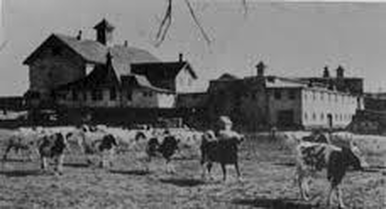
CASTLE HILL FARM
1874 - 1957
Destroyed by fire in 1957
At the Fall town meeting of October 25, 2022, the voters approved the use of Community Preservation Funds for the acquisition of 97-acres of historic Castle Hill Farm property.
1874 - 1957
Destroyed by fire in 1957
At the Fall town meeting of October 25, 2022, the voters approved the use of Community Preservation Funds for the acquisition of 97-acres of historic Castle Hill Farm property.
Very little is known about the early history of this farm. Rumor was that Castle Hill Farm was bought from Indians for two kegs of whiskey. Not so, but it was a good legend.
We do know that the farm had a tremendous impact on the population of Whitinsville.
The farm tract was comprised of several parcels of land that were different forms. There was one Little Island of land that was in the middle of a big field that John C. Whitin could not buy after he had established the farm. He eventually combined the different areas of the small separate farms into the wide open expanse of farmland that made up Castle Hill Farm.
It is known that John C. Whitin started to clear the land during the Depression of 1874-1879.
During the Depression little work was available. The work week at Whitin Machine Works was cut down to four days but John C. retained all the men who had dependents. The single men without dependents were hired to help build Memorial Hall and clear stones from his 70 acre farm on Castle Hill. The farm provided much work for the unemployed.
Most of the men who worked on the farm were paid $1.10 per day. In The Shop, they were paid $1.50 per day. Yet, the stone-clearing tasks were such that anyone who wanted to work on the farm was welcome.
The Great Stone Wall
The Great Stone Wall that still bounds the field was built during the time of the 1874 Depression. Work was indeed difficult and the turnover among the men who labored on the farm was very high. They worked there only when they really needed money. It was estimated that it cost John C. Whitin $13,000 to clear the field. It was completed in 1880.
Many of the stones seen today are still grooved with chisel marks from where the stones were split by hand.
It is one of the grandest stone walls in Massachusetts.
Sarah Elizabeth (Pratt) Whitin
After John C. Whitin passed away in 1882, the farm was left to his second wife, Sarah, who ran it as a model dairy farm. John C. Whitin's first wife, Catherine Haven Leland, died in 1872.
Tuberculosis
In early 1886, fifteen of her twenty-six registered Jersey cows got tuberculosis and died. In order to restock her herd, she sent for a number of Holstein cows from Friesland, the Netherlands. They were shipped here, and a hired hand named John Bosma was sent along to care for the new herd. When he arrived in Whitinsville, he asked to be allowed to stay and to take care of the cows he had brought. The next spring, he sent home for his sister and her husband, William B. Feddema. Feddema’s brother, Peter, came over the next year, followed by his wife and their five children. Jake and William Feddema, who had worked in "The Shop," were two of those five children.
Virtually all of Whitinsville's present Dutch families owe their existence in the town, through one connection or another, to the early start made back in 1886-1888 by Mr. John Bosma and the Feddema family. Henry A. Kooistra, who had been president of the Whitin Foremen's Club, was born at Castle Hill. His grandfather was one of the originals who had come from Friesland in 1886 to help in the early growth and development of the dairy business at Castle Hill Farm.
George Marston Whitin and the Machine Works
In 1919, following the death of Sarah (Pratt) Whitin, George Marston Whitin took over Castle Hill Farm. Then the Company of Whitin Machine Works took over the historic Castle Hill Farm, and under the personal direction of E. Kent Swift, converted it from a hobby showplace to a paying enterprise. Milk and other dairy products were sold to the schools and homes of shop workers in addition to being sold within The Shop, in the Shop's cafeteria, and on the farm itself.
R.O. Robie came to Castle Hill as superintendent of the farm in 1920. Then, there were 60 head of cattle. They produced 225 quarts of milk daily. Later, there were 175 heads of Ayrshires, all but three were bred and raised on the farm. They produced 900 - 1,000 quarts of milk daily. Seven hundred quarts were distributed in The Shop and the rest sold elsewhere in the town.
Castle Hill Farm supplied milk to the Blue Eagle Inn, the cafeteria, the Whitinsville Hospital, and the schools.
1955
The farm was sold to the Garelick Family in 1955 for $56,000.
Fire in 1957
Unfortunately, this dairy barn was not destined to be productive for a long time. A spectacular fire consumed it and all its contents in 1957. The fire lit up the whole town. Teenagers watched from their yards miles away, or road their bikes to get a better look. The main barn was completely destroyed by the fire.
National Historic Register
Castle Hill Farm is part of the National Historic Register. In 2007, Preservation Massachusetts listed as one of the state's most endangered historic resources.
An informative presentation of Castle Hill was made in April 2013 by Historical Society member Jack Crawford.
S.J. Buma
